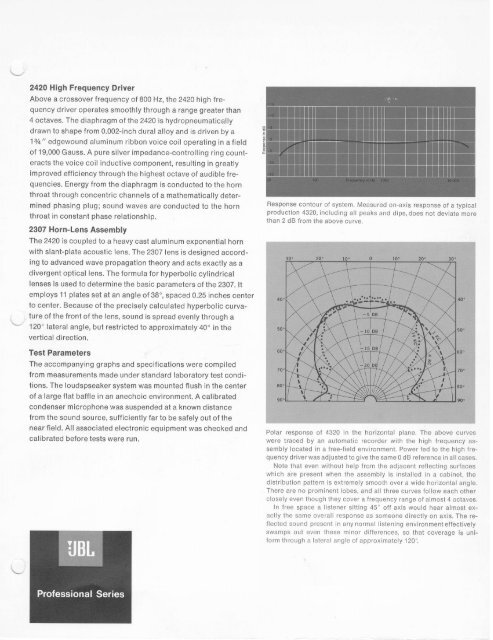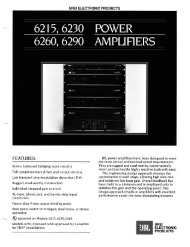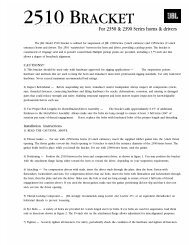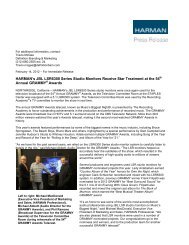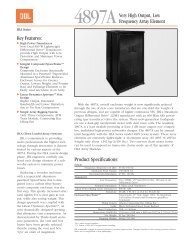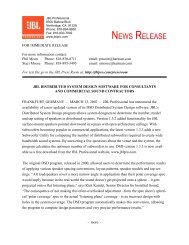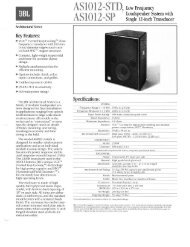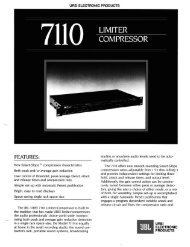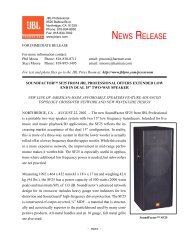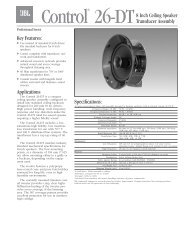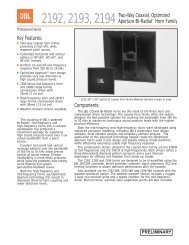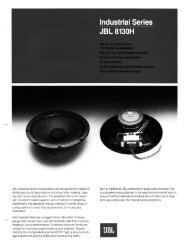Professional two way loudspeaker components ... - JBL Professional
Professional two way loudspeaker components ... - JBL Professional
Professional two way loudspeaker components ... - JBL Professional
You also want an ePaper? Increase the reach of your titles
YUMPU automatically turns print PDFs into web optimized ePapers that Google loves.
2420 High Frequency DriverAbove a crossover frequency of 800 Hz, the 2420 high frequencydriver operates smoothly through a range greater than4 octaves. The diaphragm of the 2420 is hydropneumaticallydrawn to shape from 0.002~inch dural alloy and is driven by a1 J/4” edgewound aluminum ribbon voice coil operating in a fieldof 19,000 Gauss. A pure silver impedance-controlling ring counteractsthevoice coil inductive component, resulting in greatlyimproved efficiency through the highest octave of audible frequencies.Energy from the diaphragm is conducted to the hornthroat through concentric channels of a mathematically determinedphasing plug; sound waves are conducted to the hornthroat in constant phase relationship.2307 Horn-Lens AssemblyThe2420 is coupled to a heavy cast aluminum exponential hornwith slant-plate acoustic lens. The 2307 lens is designed accordingto advanced wave propagation theory and acts exactly as adivergent optical lens. The formula for hyperbolic cylindricallenses is used to determine the basic parameters of the 2307. Itemploys 11 plates set at an angle of 38”, spaced 0.25 inches centerto center. Because of the precisely calculated hyperbolic curvatureof the front of the lens, sound is spread evenly through a120” lateral angle, but restricted to approximately40” in thevertical direction.Test ParametersThe accompanying graphs and specifications were compiledfrom measurements made under standard laboratory test conditions.The loudspseakersystem was mounted flush in the centerof a large flat baffle in an anechoic environment. A calibratedcondenser microphone was suspended at a known distancefrom the sound source, sufficiently far to be safely out of thenear field. All associated electronic equipment was checked andcalibrated before tests were run.Polar response of 4320 in the horizontal plane. The above curveswere traced by an automatic recorder with the high frequency assemblylocated in a free-field environment. Power fed to the high frequencydriverwasadjustedtogivethesameDdB reference inall cases.Note that even without help from the adjacent reflecting surfaceswhich are present when the assembly is installed in a cabinet, thedistribution pattern is extremely smooth over a wide horizontal angle.There are no prominent lobes. and all three curves follow each otherclosely ewn tho”gh they cover a frequency range of almost 4 octaves.In free space a listener sitting 45” off axis would hear almost exactlythe same overall response as someone directly on axis. The re-flected sound present in any normal listening environmenteffectivelyswamps out even these minor differences, so that coverage is uni-form through a lateral angle of approximately 1204


